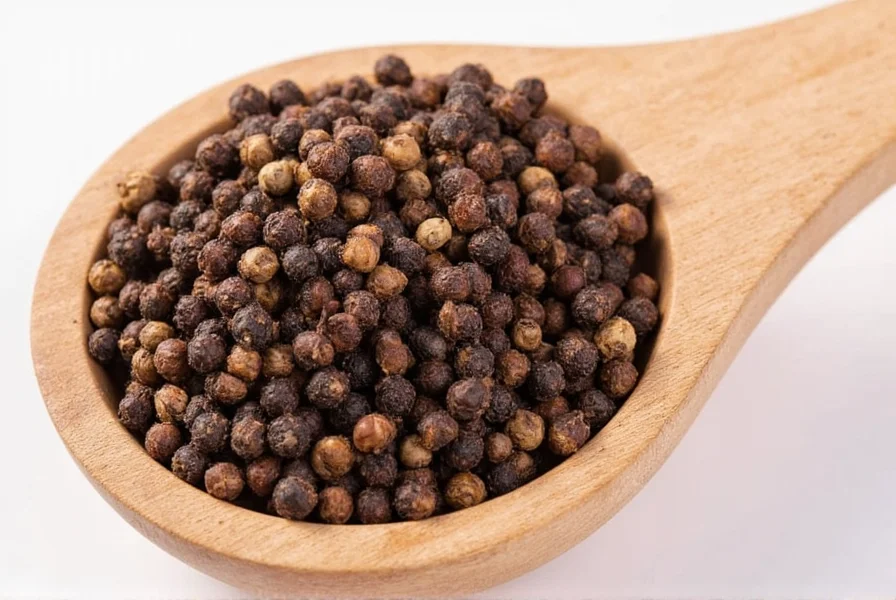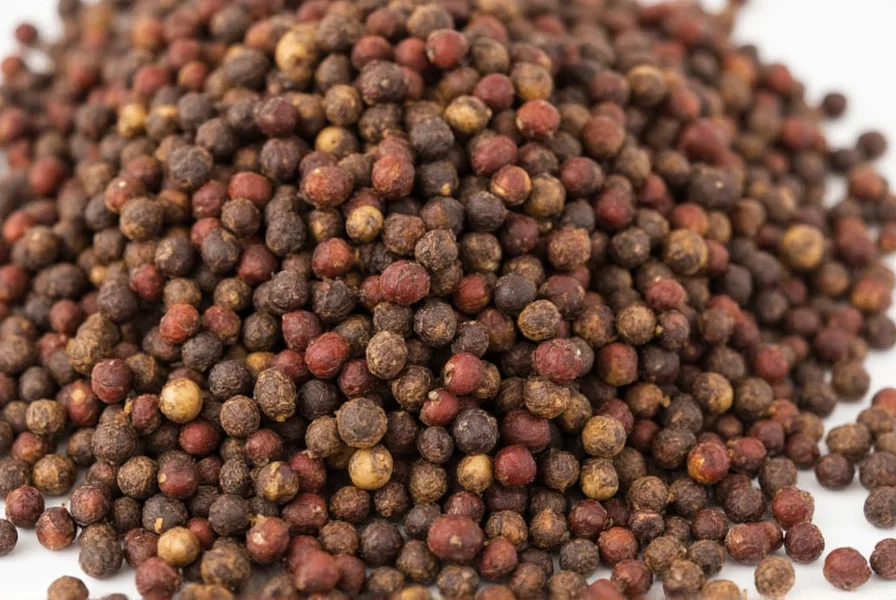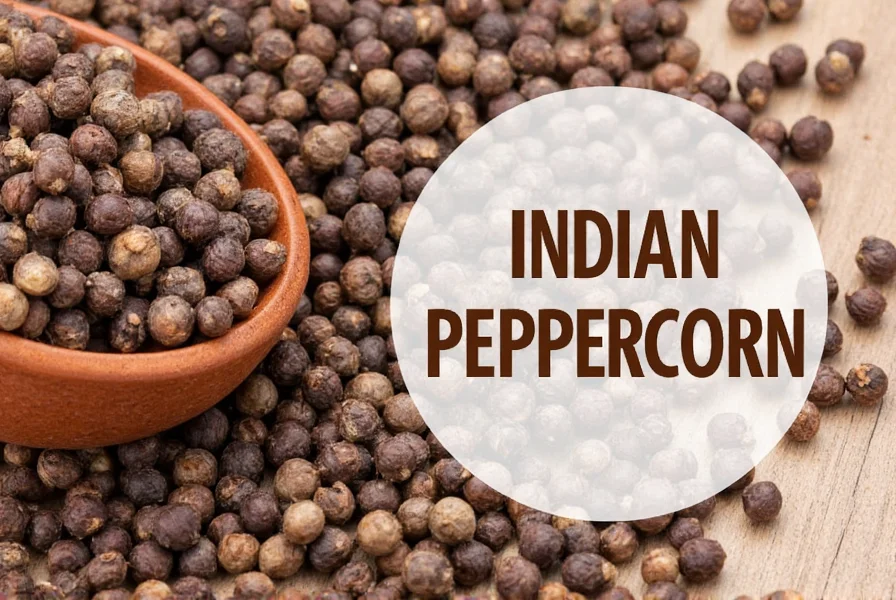When exploring the world of premium spices, Indian peppercorn stands as one of the most revered varieties globally. Originating from Kerala's lush Western Ghats region, these peppercorns have been traded along ancient spice routes for millennia. The unique tropical climate, combined with traditional farming methods, produces peppercorns with exceptional aromatic complexity that chefs and home cooks prize for elevating dishes.
Understanding Indian Peppercorn Varieties
India produces several distinguished peppercorn varieties, each with distinctive characteristics:
| Variety | Harvest Timing | Flavor Profile | Size Grade |
|---|---|---|---|
| Malabar Black | Partially ripe berries | Classic pepper heat with woody notes | 5.0-5.5mm |
| Tellicherry Extra Bold | Full ripeness (larger berries) | Complex citrus, floral, and pine notes | 4.25mm+ |
| Malabar White | Fully ripe berries, soaked & dried | Milder, earthier flavor | 5.0-5.5mm |
The size grading system directly impacts flavor development. Tellicherry peppercorns, harvested from the same vine as Malabar but allowed to ripen longer, develop more nuanced flavor compounds. These larger berries (minimum 4.25mm) must comprise at least 35% of the harvest to earn the Tellicherry designation, making them rarer and more valuable.
Culinary Applications of Authentic Indian Peppercorn
Professional chefs emphasize using freshly cracked Indian peppercorn rather than pre-ground versions to preserve volatile aromatic compounds. The distinctive flavor profile makes it ideal for:
- Meat preparations: Enhances steaks and roasts with its complex heat that penetrates deeper than standard pepper
- Sauces and reductions: Adds dimension to pan sauces without overwhelming other ingredients
- Vegetable dishes: Complements roasted root vegetables and mushroom preparations
- Chocolate pairings: Creates intriguing contrasts in dark chocolate desserts
For optimal flavor extraction in Indian peppercorn marinades, toast whole peppercorns gently before crushing. This releases essential oils while preserving piperine content responsible for both heat and potential health benefits. Unlike generic black pepper, Indian varieties maintain their complexity even when cooked, making them superior for long-simmered dishes.
Health Benefits and Scientific Perspective
Research indicates Indian peppercorn contains higher concentrations of piperine (5-9%) compared to standard black pepper (4-6%). This bioactive compound shows promise in enhancing nutrient absorption, particularly curcumin from turmeric. However, these Indian black peppercorn benefits should be understood within context:
- Piperine may improve bioavailability of certain nutrients when consumed together
- Antioxidant properties are present but shouldn't be overstated
- Thermogenic effects are mild and shouldn't be considered significant for weight management
Consuming peppercorns as part of a balanced diet provides flavor complexity without the health claims often associated with superfood marketing. The traditional Ayurvedic use of pepper in digestion-focused preparations has some scientific backing, though modern applications should prioritize culinary excellence over medicinal promises.
Identifying Genuine Indian Peppercorn
With increasing demand, authentic Indian peppercorn faces competition from lower-quality substitutes. When selecting where to buy genuine Indian peppercorn, consider these verification methods:
- Visual inspection: Look for uniform dark brown to black color with slight sheen (not matte)
- Aroma test: Fresh peppercorns should have bright, citrusy top notes with underlying warmth
- Texture: Should feel dense and hard, not lightweight or brittle
- Origin labeling: Authentic products specify region (e.g., "Malabar Coast") not just "India"
Reputable spice merchants often provide harvest dates, as peppercorns gradually lose volatile compounds over time. For the most vibrant flavor in authentic Indian peppercorn recipes, use within 12 months of harvest. Store in airtight containers away from light and moisture to preserve essential oils.

Practical Usage Tips for Home Cooks
Maximizing the potential of Indian peppercorn requires understanding its unique properties. Unlike standard pepper, these varieties benefit from specific handling techniques:
- Grinding: Use a coarse setting to release oils gradually during cooking
- Timing: Add early in cooking for infused dishes, late for pronounced pepper notes
- Pairings: Complements citrus, cream, and rich meats better than generic pepper
- Substitutions: Use 25% less than standard pepper due to higher potency
For those exploring how to use Indian peppercorn in cooking, start with simple applications like finishing roasted vegetables or enhancing pan sauces. The nuanced flavor becomes particularly apparent when used in dishes where pepper plays a starring role, such as steak au poivre or creamy pasta sauces. Remember that quality Indian peppercorn shouldn't cause harsh aftertastes—its heat should be present but balanced with complex aromatic notes.

Conclusion: Elevating Your Culinary Experience
Understanding the distinctive qualities of Indian peppercorn transforms how you approach seasoning. These premium peppercorns offer more than just heat—they provide a flavor journey that enhances dishes without overwhelming them. By selecting authentic varieties and using proper techniques, home cooks can achieve restaurant-quality results that showcase the true potential of this ancient spice. Whether you're crafting authentic Indian peppercorn recipes or simply elevating everyday cooking, these peppercorns represent the pinnacle of pepper cultivation where terroir, tradition, and taste converge.
Frequently Asked Questions
What makes Indian peppercorn different from regular black pepper?
Indian peppercorn varieties like Malabar and Tellicherry come from specific regions in India's Western Ghats and are harvested at precise ripeness stages. They contain higher piperine concentrations (5-9% vs 4-6%) and develop more complex flavor compounds including citrus, floral, and pine notes absent in generic black pepper. The terroir of Kerala's tropical climate creates distinctive aromatic profiles that generic commercial pepper lacks.
How should I store Indian peppercorn to maintain freshness?
Store whole Indian peppercorns in an airtight container away from light, heat, and moisture. The ideal container is opaque glass or ceramic with a tight seal. Properly stored, they maintain peak flavor for 12-18 months. Avoid plastic containers as they can absorb odors. Never store near stovetops or in refrigerators where temperature fluctuations and humidity degrade quality. For best results in how to use Indian peppercorn in cooking, grind only what you need immediately before use.
Can I substitute Indian peppercorn in traditional recipes?
Yes, but adjust quantities as Indian peppercorn is typically 20-25% more potent than standard black pepper. For authentic Indian peppercorn recipes requiring specific varieties, substitutions may alter the intended flavor profile. In European dishes, Tellicherry works well as a premium substitute, while Malabar provides more traditional pepper notes. When substituting in spice blends, reduce by 1/4 teaspoon per tablespoon to prevent overpowering other spices. The nuanced citrus notes in premium Indian varieties won't translate in recipes specifically designed for standard pepper's simpler profile.
Are there noticeable health benefits to using Indian peppercorn?
Indian peppercorn contains higher piperine levels which may enhance nutrient absorption, particularly when paired with turmeric. However, these Indian black peppercorn benefits should be viewed as complementary to a balanced diet rather than therapeutic. The antioxidant properties are present but modest. Consuming peppercorns as part of regular cooking provides flavor complexity without significant physiological effects. Don't expect dramatic health improvements from normal culinary usage, though traditional Ayurvedic preparations using pepper for digestive support have some scientific basis when used appropriately.











 浙公网安备
33010002000092号
浙公网安备
33010002000092号 浙B2-20120091-4
浙B2-20120091-4